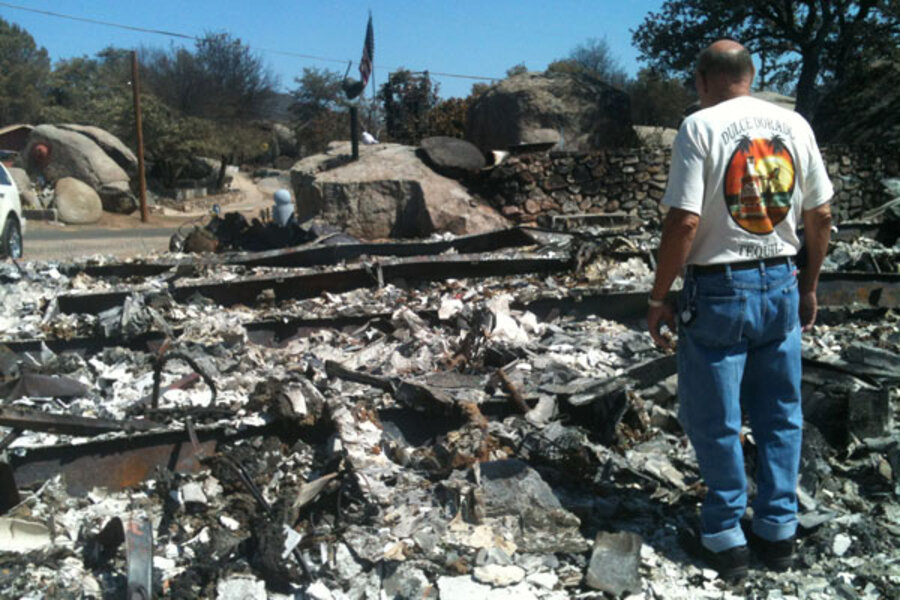From ashes of Yarnell fire, devastated town finds renewal
Loading...
| YARNELL, ARIZ.
The reminders of the summer wildfire that hit this tiny mountain enclave are hard to miss. Piles of charred rubble sit where homes once stood and blackened tree skeletons dot a boulder-covered landscape that still bears the reddish marks of fire suppressants.
But beyond the devastation of the lightning-caused blaze that killed 19 firefighters June 30, some signs point to a community slowly emerging from the desolation of one of the nation's worst wildfires.
Eateries and storefronts are open for business. The Friday night crowd coming to the town's diner for live music has swelled. And on Saturday, a groundbreaking ceremony will herald construction of the first home since the fire.
"We want to rebuild the town so the 19 didn't die in vain," says Chuck Tidey, chairman of the Yarnell Recovery Group.
The destruction was a huge blow for a hardscrabble town where most of its roughly 650 residents are retirees with an average yearly income of about $16,000. Some 100 homes, including prefab structures, burned to the ground. Several affected homeowners lacked home insurance, either because they couldn't afford it or because old houses were not up to code.
Like many Yarnell residents, Vicki Velasquez traded city life for Yarnell's tranquility, moving here nine years ago. She bought a shop where she sells turquoise jewelry, T-shirts, and an eclectic collection of arts and crafts. She lived in an apartment beneath her business while she gradually fixed up a house.
She was moving in to the house with her dog, a boxer named Lizzie, the day the fire forced them out of town.
"I never got to live in it," Ms. Velasquez says through tears.
When she returned to Yarnell a few days after the fire, Velasquez could salvage little from the ruins. Where her garage had been she recovered several dozen ceramic eggs that residents are now decorating to raise funds. Her outdoor 1950s-style furniture and her '56 gold Chrysler were largely unscathed.
Velasquez had no homeowners insurance.
"It was uninsurable because of the age," she says. "It was built in the '50s, in the boulders."
As Velasquez speaks, Mr. Tidey, who is browsing through the store, walks behind the counter and hugs her.
His long, gray hair gathered into a ponytail, Tidey says the recovery group, which has received about $1.5 million in donations, will prioritize rebuilding homes for uninsured homeowners like Velasquez – largely with volunteer labor.
"Everybody is just overwhelmed with the generosity of people," he adds.
He recalls watching the roiling flames in the distance while scrambling eggs and jalapeño peppers for breakfast that Sunday morning. The fire, which had sparked two days earlier, advanced away from Yarnell and the roomy adobe house Tidey shares with his wife.
But strong winds later changed direction, blowing the fire out of control. The blaze overcame all but one of the Granite Mountain Hotshots from nearby Prescott, Ariz., and spread through the evacuated community. By the time it was contained July 10, the Yarnell Hill Fire had burned 8,400 acres.
Tidey's home was spared, and the former Army helicopter pilot is well aware that the death of the hotshots renewed a national debate over whether firefighters should risk their lives to save the property of people who build in fire-prone areas.
The loss of life was unfortunate, Tidey says, but firefighters know the risks that come with the job.
A national team of investigators is trying to determine exactly what went wrong to help prevent similar fatalities in the future. The findings are expected sometime in September.
Near Yarnell's business district, purple felt banners with a "19" in the center hang from store windows. Not far away, a memorial displays photos and biographies of the fallen hotshots.
Stacy Pizzirusso, who owns a fashion boutique, made the banners to honor the firefighters. Her own home succumbed to the flames. By the time she returned to Yarnell, she already knew her house was nothing but ashes. The remnants had flashed on a TV screen.
"It just doesn't seem real, even to this day," Ms. Pizzirusso says, sitting on a bench outside her shop.
But she is forging ahead. Over the weekend, she and her husband will break ground for a new house to replace the one lost. It will be a celebration for the whole town, complete with a barbecue and music.
"I want to let people know that if we can do it, so can they," adds Pizzirusso.
Down the street, restaurateur Chris Johnson has reopened his diner after a 10-day shutdown. His customers are slowly coming back, and the presence of those who lost their homes is particularly noticeable Friday nights. Local singer Denise Roggio's "Yarnell Rising," which Mr. Johnson describes as a heartfelt song of hope, is a big draw.
"They come in just to celebrate a little bit, get a little happiness in their lives instead of the tragedy that they have to remember," he says.







